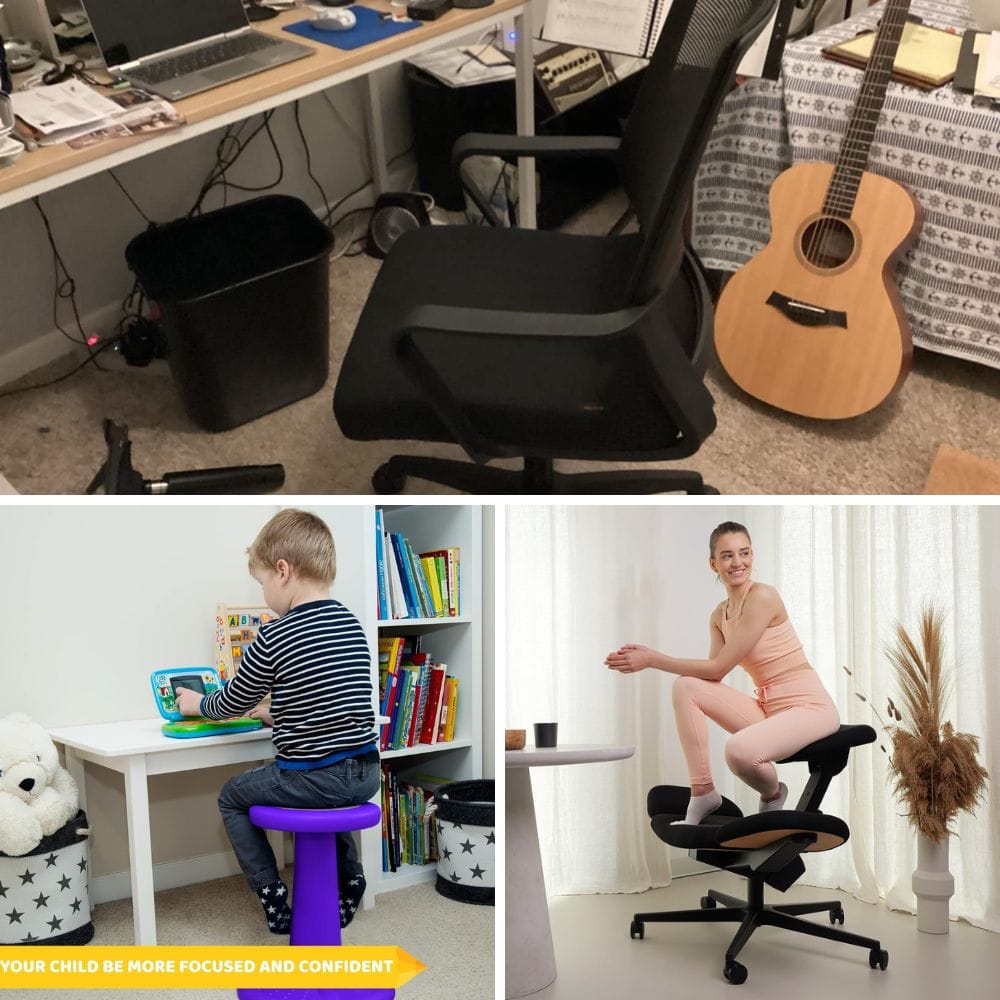Key Takeaways:
- ADHD chairs support individuals with attention deficit hyperactivity disorder by promoting active sitting and reducing restlessness.
- These chairs come in various forms, including ergonomic chairs, kneeling chairs, and yoga balls, each offering unique benefits for maintaining focus and healthy posture.
- Choosing the right seating option can significantly impact one's ability to stay focused and manage ADHD symptoms effectively.
Introduction to ADHD Chairs

When it comes to managing attention deficit hyperactivity disorder (ADHD), finding the right seating solution can be a game-changer. ADHD chairs, as they are commonly known, are specifically designed to cater to the unique needs of individuals with ADHD. These chairs provide a dynamic seating experience that encourages movement and helps reduce restlessness, making them an essential tool for both children and adults.
ADHD chairs are not just about sitting; they are about creating an environment that supports focus and reduces anxiety. By incorporating elements like active sitting and ergonomic design, these chairs help individuals remain seated for longer periods without discomfort. Whether it's a traditional chair with a twist or a more unconventional seating option, ADHD chairs are all about enhancing one's ability to concentrate and stay engaged.
The Science Behind ADHD Chairs
The concept of ADHD chairs is rooted in the understanding of how movement can aid concentration. For individuals with ADHD, remaining seated for long periods can be challenging due to excess energy and the need for constant movement. ADHD chairs address this by allowing for subtle movements that engage core muscles and provide proprioceptive feedback, which can help reduce restlessness and improve focus.
Research has shown that active sitting, which involves slight movements while seated, can be beneficial for those with ADHD. This type of seating encourages a healthy posture and helps individuals stay focused on tasks by providing the physical activity their bodies crave. By incorporating movement into the sitting position, ADHD chairs offer a practical solution for managing ADHD symptoms.
Types of ADHD Chairs
Ergonomic Chairs
Ergonomic chairs are designed to support the body's natural posture and reduce strain during prolonged sitting. These chairs often feature adjustable armrests, lumbar support, and the ability to adjust to different heights, making them ideal for individuals with ADHD who need to stay focused for extended periods.
The ergonomic design of these chairs helps distribute weight evenly, reducing the risk of pain and discomfort. By promoting a healthy posture, ergonomic chairs can help individuals with ADHD maintain concentration and reduce the likelihood of fidgeting or becoming easily distracted.
Kneeling Chairs
Kneeling chairs are another popular option for those with ADHD. These chairs encourage a forward-leaning sitting position that engages the core muscles and promotes active sitting. By distributing weight between the shins and buttocks, kneeling chairs help reduce pressure on the lower back and improve posture.
The unique design of kneeling chairs allows for a more dynamic seating experience, which can be particularly beneficial for individuals with ADHD. By providing a seating option that encourages movement, kneeling chairs help reduce restlessness and support focus during tasks that require fixed attention.
Yoga Balls
Yoga balls, also known as stability balls, are a versatile seating option for individuals with ADHD. These balls provide a dynamic sitting experience that encourages movement and engages core muscles. By allowing for subtle bouncing and shifting, yoga balls help reduce restlessness and improve focus.
The use of yoga balls as chairs is particularly popular in schools and homes where children with ADHD need to stay engaged during activities. The proprioceptive feedback provided by the ball helps individuals stay focused and manage their excess energy effectively.
Benefits of ADHD Chairs
Promoting Active Sitting
One of the primary benefits of ADHD chairs is their ability to promote active sitting. By encouraging movement, these chairs help individuals with ADHD stay focused and reduce restlessness. Active sitting engages core muscles and provides the physical activity needed to manage ADHD symptoms effectively.
Active sitting is not just about movement; it's about creating an environment that supports concentration and reduces anxiety. By allowing for subtle movements, ADHD chairs help individuals remain seated for longer periods without discomfort, making them an essential tool for managing ADHD.
Supporting Healthy Posture
ADHD chairs are designed to support a healthy posture, which is crucial for maintaining focus and reducing discomfort during prolonged sitting. By promoting a natural sitting position, these chairs help distribute weight evenly and reduce the risk of pain and discomfort.
A healthy posture is essential for individuals with ADHD, as it helps reduce the likelihood of fidgeting and becoming easily distracted. By providing the right support, ADHD chairs help individuals stay focused and engaged during tasks that require fixed attention.
Exploring Alternative Seating: Standing Desks and Meditation Chairs
When it comes to creating an environment conducive to focus and relaxation, standing desks and meditation chairs offer intriguing alternatives. Standing desks allow individuals to work in a standing position, which can be particularly beneficial for those who find sitting for extended periods challenging. This setup encourages good posture and can help reduce the impact of external stimuli by keeping one’s body engaged. On the other hand, a meditation chair provides a unique opportunity to sit cross-legged, promoting relaxation and mindfulness. This can be especially useful in activities involving fixed attention, where maintaining focus is paramount.
Incorporating these options into various settings, such as schools or offices, can cater to diverse physical needs and preferences. For example, kids in a classroom might benefit from the flexibility of standing desks, allowing them to shift positions and stay engaged. Meanwhile, adults working from home might find that a meditation chair helps them unwind and concentrate better. By offering a variety of seating solutions, we can address the unique needs of each individual, enhancing self-esteem and productivity. Whether at school or in the house, these seating options provide a fresh idea for fostering a more dynamic and supportive environment.
The Impact of Active Chairs on Focus and Relaxation
Active chairs, such as wobble stools and balance balls, are designed to keep the body moving even while seated. This movement can help channel physical energy and improve focus, making them an excellent choice for children and adults alike. By allowing users to shift and adjust their positions, active chairs can reduce restlessness and enhance concentration during activities involving fixed attention. This dynamic seating option can be particularly beneficial in environments where maintaining focus is crucial, such as during study sessions or work meetings.
Moreover, active chairs can play a significant role in promoting relaxation and reducing anxiety. By providing proprioceptive feedback, these chairs help users become more aware of their bodies, which can lead to improved self-esteem and a sense of calm. For instance, a child using an active chair in school might find it easier to manage stress and stay engaged with their lessons. Similarly, an adult working from a browser at home might experience less tension and greater productivity. By integrating active chairs into various settings, we can create a more supportive and adaptable environment that meets the diverse needs of its users.
Understanding Specific Needs
When selecting an ADHD chair, it's important to consider the specific needs of the individual. Different chairs offer unique benefits, and what works for one person may not be suitable for another. Factors such as age, height, and the type of activities the chair will be used for should be taken into account.
A chair that allows for movement and provides proprioceptive feedback can be particularly beneficial. For adults, an ergonomic chair that supports a healthy posture and reduces discomfort during prolonged sitting may be more appropriate.
Trying Different Seating Options
It's advisable to try different seating options to find the one that best meets the individual's needs. Whether it's a kneeling chair, yoga ball, or ergonomic chair, each option offers unique benefits that can help manage ADHD symptoms effectively.
Experimenting with different chairs can help identify the most comfortable and supportive option. By finding the right seating solution, individuals with ADHD can improve their focus, reduce restlessness, and enhance their overall well-being.
Incorporating ADHD Chairs in Various Settings
At Home
Incorporating ADHD chairs at home can create a supportive environment for individuals with ADHD. Whether it's a yoga ball in the living room or an ergonomic chair in the home office, these seating options can help reduce restlessness and improve focus during daily activities.
Creating a space that supports concentration and reduces anxiety is essential for managing ADHD at home. By providing the right seating options, individuals can stay focused and engaged, whether they're working on a task or relaxing with family.
In Schools
ADHD chairs are increasingly being used in schools to support students with ADHD. By providing seating options that promote active sitting and healthy posture, schools can create an environment that supports focus and reduces restlessness.
Incorporating ADHD chairs in classrooms can help students stay engaged during lessons and improve their overall academic performance. By providing the right tools, schools can support students with ADHD and help them succeed in their educational journey.
The Role of ADHD Chairs in Reducing Anxiety
Providing Proprioceptive Feedback
ADHD chairs provide proprioceptive feedback, which can help reduce anxiety and improve focus. By engaging core muscles and allowing for subtle movements, these chairs help individuals manage their excess energy and stay focused on tasks.
Proprioceptive feedback is particularly beneficial for individuals with ADHD, as it helps them stay grounded and reduces the likelihood of becoming easily distracted. By providing the right support, ADHD chairs can help individuals manage their anxiety and improve their overall well-being.
Enhancing Self-Esteem
Using ADHD chairs can also enhance self-esteem by providing a seating solution that supports focus and reduces restlessness. By allowing individuals to stay engaged and succeed in their tasks, these chairs can boost confidence and improve self-esteem.
For children, having a chair that supports their specific needs can make a significant difference in their academic performance and social interactions. By providing the right seating options, parents and educators can help children with ADHD build self-esteem and succeed in their daily activities.


What are ADHD chairs called?
ADHD chairs are often referred to as active chairs, ergonomic chairs, or dynamic seating options. These chairs are designed to support individuals with ADHD by promoting movement and reducing restlessness.
How do ADHD chairs help with focus?
ADHD chairs help with focus by promoting active sitting and providing proprioceptive feedback. These chairs engage core muscles and help individuals manage their excess energy by allowing for subtle movements, improving concentration, and reducing restlessness.
Are ADHD chairs suitable for children?
Yes, ADHD chairs are suitable for children and can be particularly beneficial in supporting focus and reducing restlessness. Options like yoga balls and kneeling chairs provide dynamic seating experiences that help children stay engaged during activities and improve their overall well-being.

ADHD chairs are a valuable tool for managing attention deficit hyperactivity disorder. By promoting active sitting and supporting healthy posture, these chairs help individuals stay focused and reduce restlessness. Whether it's an ergonomic chair, kneeling chair, or yoga ball, each option offers unique benefits that can enhance concentration and improve overall well-being. By choosing the right seating solution, individuals with ADHD can create an environment that supports focus and reduces anxiety, ultimately improving their quality of life.











